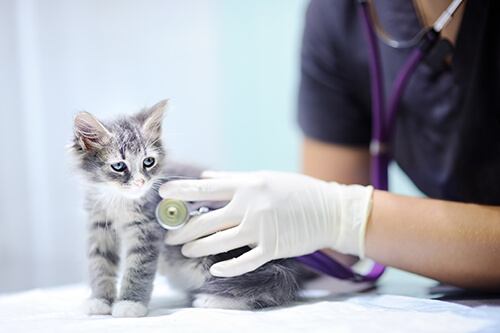
Unfortunately, some pet owners are not concerned about their dog or cat being overweight. Some families even find heavy pets to be cute, funny or charming – for instance, chubby dogs and cats are seen as having “character” or “personality.”
But any veterinarian will tell you that being overweight is a serious health concern for pets. Animals are loveable at any size and weight, but carrying too much body fat can be very detrimental to their lifespan and quality of life.
What are the health risks for overweight pets?
Excess weight may put stress on your pet’s joints, ligaments and bones, which can lead to an increased risk for joint disease, chronic pain and limited mobility.
Overweight pets may have difficulty breathing (especially flat-faced or brachycephalic breeds), heat intolerance, hygiene issues, skin problems, and increased surgical and anesthetic risk. High body fat may also lead to diabetes and heart disease.
Any of these conditions can result in a shorter lifespan and a poorer quality of life for your pet. For further discussion of the effects of excess weight on your pet, visit the Veterinary Partner website and search “Obesity.”
The Body Condition Score can determine if your pet is overweight.
The American Animal Hospital Association (AAHA) has developed a method for measuring dogs’ and cats’ body composition known as the Body Condition Score (BCS).
The Body Condition Score can be measured on either a 5-point scale or a 9-point scale. If using the 5-point scale, the goal BCS for most pets is between 2.5 to 3. If using the 9-point scale, aim for a BCS of 4 to 5.
Disease risk associations with higher BCS in adult animals appear to increase above 3.5 of 5, or above 6 of 9. If your pet falls within this range, they likely need to lose body fat.
Note that a healthy BCS may appear “too thin” to some pet owners, so it’s important to consult with your veterinarian and bring your dog or cat in for a full evaluation.
How to evaluate your pet’s Body Condition Score at home:
First, review the AAHA diagram for the Body Condition Score system. Then, evaluate your pet based on the characteristics outlined in the diagram.
Below are a few traits that pets within a healthy weight range have in common:
- When viewing your pet from above, they have an hourglass shape with a tapered waist after the ribs. They should NOT have an egg shape.
- When viewing your pet from the side, you should see an abdominal tuck behind the last ribs. You should NOT see a rounding or distension of the abdomen.
- Ribs are palpable with a minimal or slight fat covering. When lightly running your hands along the rib cage, you can feel the ribs, but not see them. If you have to push your fingers in to find the ribs, you are pushing through excess fat.
- Fat pads over the hips, but not a heavy amount of fat cover.
Conversely, you do not want your pet to be underweight. You do not want to see individual ribs, protruding hip bones or prominent spine.
Your veterinarian can evaluate your pet’s Body Condition Score and offer guidance on weight loss or maintenance.
We want your pets to be as healthy as possible and a long, happy, active life with you. Contact your vet today if you have questions about your pet’s weight or Body Condition Score!